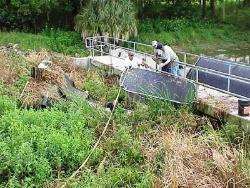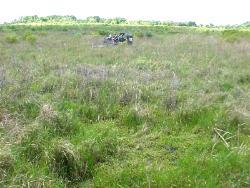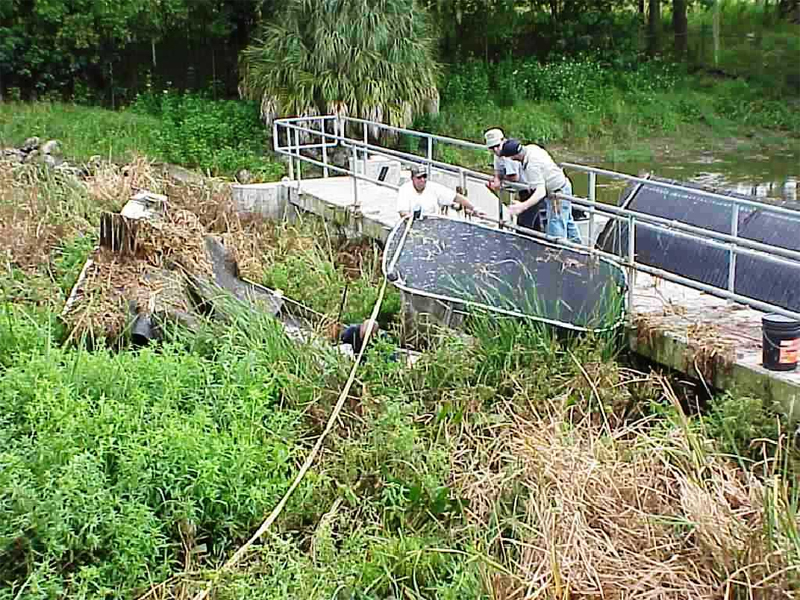Managing Tussocks and Floating Islands
The decision to manage tussocks and floating islands is often difficult because they are usually made up of native plants that provide habitat for fish and wildlife. Once a decision is made to proceed with control, the most cost-effective methods that are compatible with the uses and functions of the water body are selected and management is coordinated among agencies and stakeholders with interests in that water body. Tussock and floating island control usually requires integrating several methods to alleviate the problem.
Tussock Control
Most tussock control is achieved using herbicides registered with the U.S. Environmental Protection Agency and approved by the Florida Department of Agriculture and Consumer Services. Tussock management using herbicides costs about $150-200 per acre (2018). The most appropriate herbicide is chosen to control the target tussock plants as well as provide the greatest measure of protection for adjacent beneficial rooted plants. Examples:
- 2,4-D is applied to control Cuban club-rush mats or rafts of pennywort
- Glyphosate is used to control rafts of paragrass
- Mixtures of 2,4-D and glyphosate or diquat are applied to frog’s bit mats
- Imazamox is used to control rafts of wild taro
- Imazapyr or triclopyr are used to control tussocks with mixed vegetation including woody species like water primrose and willow.
Much of the floating tussock controlled with herbicides decomposes at the surface. Some of the material falls to the bottom to break down further. Even more organic material would be deposited on the lake bottom over time if the tussock was not controlled. By removing long-existing tussocks, wave action, oxygen, and light can once again reach the sediments to further break down accumulated organic deposits and stimulate regeneration of rooted submersed and emergent plants. Control of tussocks as they begin to form usually results in a one-time or short-term deposition of small amounts of organics that do not significantly impact the lake bottom.
Occasionally tussocks must be immediately controlled, such as when they become lodged against bridge pilings or flood control structures. Such instances can occur during a hurricane. In these cases, much more labor intensive and expensive methods like shredders, harvesters, barge-mounted track hoes, or draglines are employed.
Floating Island Control
The greatest difference between tussock and floating island management is that tussocks can be inexpensively controlled with herbicides whereas floating islands must be dismantled and/or removed using machines. Machines cost from $3,000 to $15,000 or more per acre (2018). High cost is another reason managers are reluctant to control floating islands unless their removal is absolutely necessary.
There is enormous variability among floating islands, from the composition and thickness of suspended sediments to the type and amount of vegetation growing at the surface. Plants range from soft tissue herbaceous plants to trees up to 10 inches in diameter and 50 feet tall. This variability requires the use of a wide array of machinery and innovation. Floating island control is a messy business and always has some level of negative impact. Removing the island means removing plant and animal habitats.
The Fish and Wildlife Commission’s Invasive Plant Management Section looks for the most cost-effective control program that is compatible with other uses and functions of the water body. In developing control plans, managers ask two very important questions:
- Will any of the potential control options cause undue harm to the uses or functions of the lake? If so, then those strategies are eliminated.
- Will one potential control strategy significantly enhance the uses and functions of the lake over another method? If the answer is no, then the most cost-effective strategies are selected.
General Methods and Strategies
Shredders
Shredders are machines with rotating blades that shred and grind suspended organic sediment material, herbaceous and woody plants, as well as trees up to 10 inches in diameter. Several variations and prototypes have been tested. All units operating in Florida lakes function with two bow-mounted counter-rotating blades that are thrust into the floating island. Shredders need about two or more feet of water depth to be most effective. Depending on vegetation and sediment density and composition, shredders can dismantle up to 10 acres of floating islands each day.
Harvesters
Harvesters are machines that can lift floating island material, including sediments and small trees, out of the water using a conveyor belt that extends from below the water surface to a storage area on the barge. Material is then transferred to a transport barge or hauled to an in-lake or shoreline disposal site. Harvesters have operated in Florida since at least the 1930s and have evolved into specialized machines that range in width from 5 to 10 feet and in carrying capacity from 4-15 tons. High-capacity harvesters can remove approximately one acre of dense floating islands each day.
For a more detailed description of mechanical control, see Section 3 – Mechanical Control. When harvesting is the method chosen for tussock and floating island control, lifting the material out of the water is just the beginning of the removal process. Harvesting, floating islands, requires hauling and disposing hundreds of tons of material, either in the lake, which adds further environmental implications, or outside of the lake. Removing harvested material from the lake requires conveyors, elevators or loaders to transfer material to trucks. If the material has a high water content and trucks drive on the road, they must be sealed. Disposal sites must be procured prior to harvesting and may require tipping fees at landfills or additional costs to purchase land or spread material out if dumped on private property or public lands.
Track Hoes and Draglines
Track hoes and draglines are used when floating islands are accessible from shorelines or rights-of-way leading to flood control structures, such as when floating islands drift onto boat ramps, public beaches or against bridges or dams. Prior to 2004, track hoes were seldom mounted on barges to go into lakes to remove floating islands. Floating islands located away from the shore were generally small enough to be controlled with shredders, harvesters or both. However, strong winds during hurricanes Charlie, Frances, and Jeanne dislodged floating islands that had been attached to shorelines for perhaps decades in several lakes, especially Pierce, Marion, and Apopka. Trees on these drifting juggernauts are too tall for conventional harvesters and too thick for most shredders alone to dismantle. Trees are secured to the track hoe boom; chain-sawed at the base, stacked on the barge and hauled to a disposal site. Track hoes or clam shells then scoop out the stump, root, and sediment mass before harvesters and shredders control the remaining contents of the floating island.
Case Studies of Tussock and Floating Island Control Projects
The following are examples of integrating several methods for controlling tussocks and floating islands in Florida public lakes.
Lake Hancock

Floating island and shredder caught in flood control structure on Lake Hancock at headwaters of Peace River (Polk Co.).
Lake Hancock in Polk County is the headwaters of the Peace River. Water exits the southwest end of the lake through an outfall canal and a flood control structure that regulates the water level and flow through Lake Hancock. Much of the bottom of Lake Hancock is covered with several feet of muck that was colonized with as much as 2,000 acres of cattail during extreme low water in the late 1990s drought. When the water level quickly rose approximately six feet in 2003, hundreds of acres of spongy, buoyant cattail pulled loose from the sediments, drifted to the outfall canal, and clogged the flood control structure.
A shredder provided immediate control to alleviate flooding while a shoreline track hoe removed remaining live cattail tussock and shredded material. The Southwest Florida Water Management District (SWFWMD) installed pilings and a cable at the mouth of the outfall canal to intercept additional drifting tussocks. Polk County personnel, SWFWMD and private sector crews applied glyphosate herbicide by helicopter and by airboats to control remaining tussocks drifting in Lake Hancock. Shredders also consumed hundreds of acres of tussocks before they could break loose and drift to the outfall structure.
Todd and Dodd Lakes
Todd and Dodd Lakes required floating island control and several approaches were tried in order to resolve problems in a fiscally as well as environmentally compatible manner. At first, floating islands were harvested and removed from the lake or piled onto small existing disposal sites within the lakes. As soon as one floating island or portion of an island was removed from navigation and boat trails, another would break off and fill the void. It quickly became apparent that all of the floating islands would need to be controlled to resolve the problem. It was also evident that costs to remove floating islands from the lakes could exceed $2 million. The in-lake disposal sites permitted by the U.S. Army Corps of Engineers would quickly exceed capacity if all of the floating islands were harvested and dumped on them.
The FWC Invasive Plant Management Section (IPMS) consulted with other agencies including Citrus County and developed a multi-faceted plan for cost-effective floating island control compatible with the uses and functions within Todd and Dodd Lakes. Tussocks were targeted for control with herbicides to prevent them from forming more floating islands.
About 150 acres of floating islands that had not yet drifted from their point of origin on the east side of the lakes were targeted for shredding provided that there were still several feet of organic deposits below them. The IPMS did not want to drop shredded material onto sandy bottom or onto residential shorelines and navigation trails. After consulting with FWC fishery managers, the IPMS was convinced that harvesting floating islands that still had 4-5 feet of organic material would not benefit fisheries. On the contrary, shredding floating islands would expose lake bottom that had been covered for years to oxygen and light, and allow fish into previously inaccessible native maidencane grass (Panicum hemitomon) marshes. Experience from similar sites also showed that shredding would draw some of the sediments from the bottom and further oxygenate them, resulting in about four feet of open water above the sediments after the floating islands were shred as opposed to 2-3 feet of open water if floating islands were only harvested.
Shredding was conducted leaving at least a 50-foot wide floating island barrier to keep shredded material from escaping to the rest of the lake and to contain turbidity within the barrier. After approximately four weeks, floating shredded material was re-shredded and any remaining material, including the barrier, was harvested, consistent with techniques learned in other lakes infested with floating islands. The shredding process took approximately two months. As many as three high-capacity harvesters removed floating islands that drifted into navigation and boat trails and access points. Repeated shredding in these areas would result in organic accumulation in areas from which it did not originate. Harvested material was stacked up to 12 feet high onto in-lake disposal sites. Small harvesters worked along shorelines to pick up small floating islands and drifting material from shredders and took it to conveyors for disposal outside of the lake.
Lake Runnymeade

Nearly 300 acres of emergent plants rose to the surface pulling as much as 3-4 feet of sediments upon reflood of Lake Runnymeade (Osceola Co.) after several years of drought.
Lake Runnymeade is a 300-acre lake connected to East Lake Toho in Osceola County. Therefore, it is part of the water management regimen that lowers central Florida lakes during the summer months to provide water storage in the event of tropical storm-related flooding. Low water and exposed sediments in the summertime provide opportunities for cattail expansion, which occurred along the perimeter of Lake Runnymeade. Cattail and other emergent species encroached far into the lake basin during the late 1990s drought. More than 200 acres of tussocks rose from the bottom following rapid re-flooding in 2002. Floating islands were a concern from both habitat and water management perspectives – blocking water inflow to recharge the lake as well as potentially flooding two neighborhoods bordering the lake.
An integrated management strategy was applied that included treating some of the vegetation with herbicides, and controlling tussocks and floating islands with shredders and harvesters. Tussocks were first shredded, leaving a containment barrier of uncontrolled plants. Some sediments settled back to the bottom while buoyant organic sediments and shredded vegetation floated at the surface where it could oxidize and harden.
Approximately 3-4 weeks after shredding, germinating plants covered the mat, reducing drying from sunlight and oxidation. At that time, the tussock remnants were harvested, much like cutting brownies from a pan, and hauled to shoreline conveyors and awaiting dump trucks. Material was hauled across the street to a donated disposal site, allowed to dry further, and then spread out across the field. Removal of the tussocks let light penetrate into the water column for the first time in several years. Agitation from the shredder and wave action from opening the water surface to wind helped to aerate the sediments, consolidating and further decomposing flocculent organic material that had filled the water column.
Lake Toho Tussock Control
An exception to controlling floating tussocks only with herbicides is the dense underwater biomass associated with rafts of the invasive Uruguayan water primrose complex (Ludwigia grandiflora/hexapetala). These Ludwigia species have been in Florida for decades but have only become invasive in recent years.
Ludwigia grandiflora/hexapetala exhibits several growth forms. Early growth is characterized by prostate, herbaceous runners with rosettes of leaves floating on the water surface. As plants mature, they become erect and eventually coalesce into dense woody masses. On Lake Toho, floating fragments drift into and colonize stands of emergent plants like Kissimmee grass (Paspalidium geminatum) and bulrush (Schoenoplectus spp.) This early growth stage soon develops into upright herbaceous shrubs several feet tall. If not managed, Ludwigia stems become woody, reaching as high as 8-10 feet tall; overgrowing and smothering other emergent plants. The underwater rhizomes of mature Ludwigia stands can reach 15-20 feet in length, forming impenetrable masses that can fill shallow waters several feet deep. Herbicides may kill the above water portion; however, unsightly and obstructive woody stems may persist for over a year. Herbicides have difficulty translocating throughout the complete rhizome system, leaving tissues to sprout and restore the mat.
Ludwigia grandiflora/hexapetala was first noticed spreading in Lake Toho in the late 2000s. It now covers more than 250 acres, much of which has overtopped Kissimmee grass and bulrush. Through research and field evaluations, FWC now employs several strategies to conserve or restore native plant habitat from this invasive plant. The early growth stage, when plants are erect and about one foot tall, is the most susceptible to herbicide control. There is a high amount of leaf surface, soft stems, and the underwater rhizome mass has not developed. Foliar applications of imazapyr mixed with carfentrazone will kill the Ludwigia, but not comingled bulrush or grass species. Mature woody stands with dense rhizome masses are harvested when conditions and funding allow. Costs to harvest range from $2,500-$3,000 if nearby in-lake disposal sites are available. Costs can more than double if plants must be removed from the lake, dried and spread in upland disposal areas.


